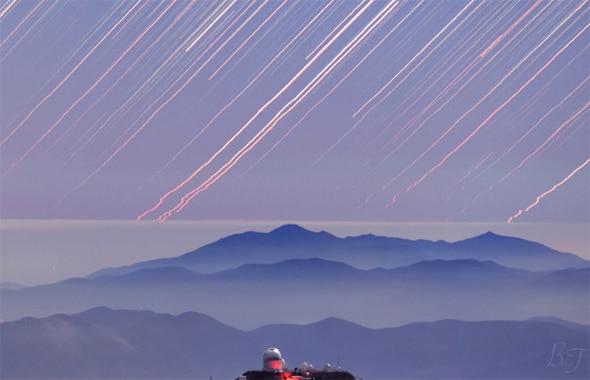Time Lapse: Refraction

Air bends light.
Well, OK, not exactly. A beam of light could pass through air all day long (as long as you have a layer of air 26 billion kilometers long) and not deviate a whit. But if the density of that air changes, the light will bend. This is called Snell’s law, and you’re already familiar with it: It’s why a spoon in a glass looks bent or broken; the light from the spoon bends as it passes from water to air, distorting what you see.
The Earth’s atmosphere has layers to it, thin blankets of air of varying temperatures and densities due to winds carrying, for example, a layer of warm air over a colder one. Light passing from one layer to another gets its direction changed slightly, what scientists call refraction. This distorts our view of objects in space; on its way to our eye the light from stars passes from one layer to the next and refracts. The results can be quite dramatic.
I could explain more, but I’ll let my friend and amazing astrophotographer Babak Tafreshi show you, in his time-lapse animation Refraction:
Whoaaaaa.
The star trails images were shot in Chile (did you notice the stars appear to set “backward,” from right to left, compared with the way we Northern Hemisphere observers are used to?). Without an atmosphere, the animation would show the stars moving along graceful, smooth arcs, appearing to set as the Earth rotates under us.
But we do have air, and so instead the lines squiggle, moving back and forth. I have to admit, that took me a moment to understand. Refraction in these cases should bend light down, not left or right! But that’s actually what you’re seeing. As a star moves down, and appears to pass through different layers of air, its light is bent down, making it appear as if the star is higher than it really is. But at the same time, the star is moving down and to the left. The refraction makes the apparent vertical movement of the star slow, but it’s still moving to the left. The result is that the star appears to move mostly left, causing the sideways jiggle.
The effect is more dramatic when you see the setting Sun (or Moon). Stars are points, so they appear as lines in the time-lapse. But the Sun is a disk on the sky, and its shape distorts profoundly as its light passes through different layers; it gets squeezed and pinched. That’s because as the Sun sets, the light from different horizontal slices of it move through different layers of air.
Picture the Sun on the horizon, sliced in half by it. The disk of the Sun is thickest on the bottom (where you see its full diameter) and gets narrower as you go up. The air layers are horizontal, and might slice across different widths of the Sun’s disk. If light from a narrow slice gets bent enough it might appear to be below a thicker slice, and the Sun looks pinched.
I know, that’s all very weird. But there’s more: The amount of bending depends on the color of the light as well. Bluer light bends more than red, and that can change the color of what you’re seeing layer by layer. In the part of the video where the Sun is setting, some layers look red, orange, and even green! This can cause the so-called green flash, when you can see a brilliant green flash of light from the Sun just as the last bit slips below the horizon. I saw this for the first time in my life recently when I was standing on the upper deck of a small boat on the Pacific Ocean, and it was amazing. The effect is so particular that people standing on the lower deck, just a couple meters lower than me, didn’t see it at all!
If it’s hard to parse all this, I totally get that; these kinds of things can be hard to wrap your head around unless you’ve had experience thinking about them. But if you take away anything from this, it’s this: Light can bend, things aren’t always as they seem, and even something as simple as watching the stars rise and set can lead to profound insight into fundamental ways the Universe works.
Learning about everything begins with noting something and thinking about it. It’s a pretty good way to go about life.



























